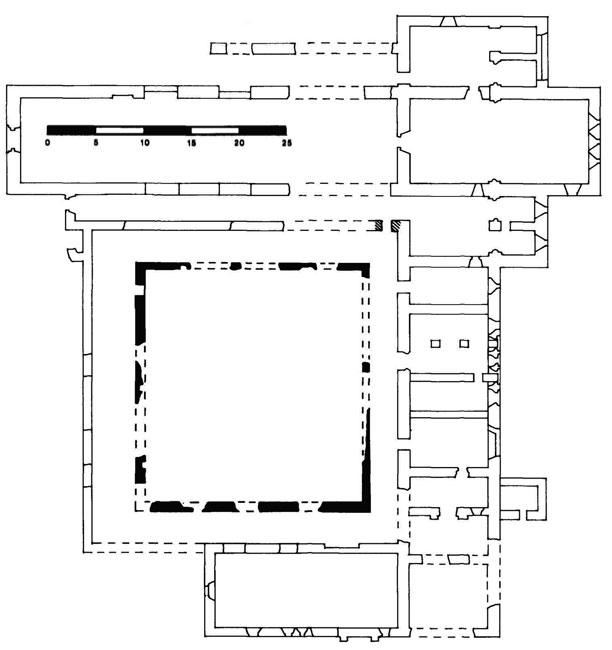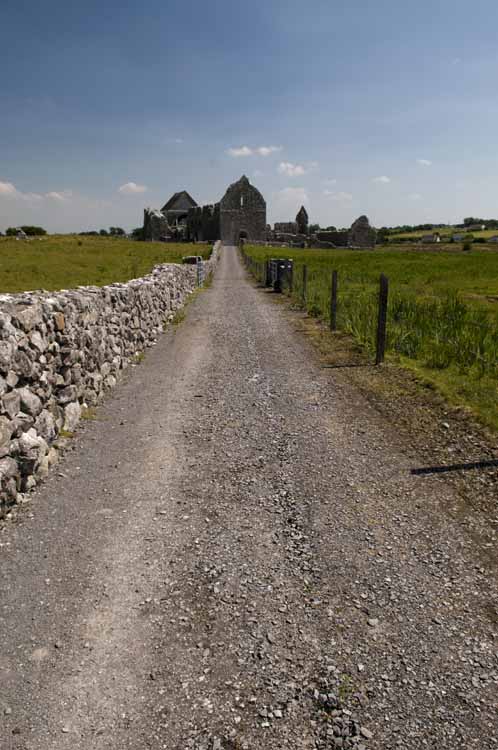The Cistercian Abbey of Abbeyknockmoy, County Galway,
Ireland, was founded in 1190 by
Cathal Crobderg
ó Conchobair [O’Connor], king of Connacht.
The first monks arrived from
Boyle
Abbey and two or three decades passed before the community commenced
construction of the permanent buildings. The abbey was situated on a
particularly desolate terrain, lying in an open valley exposed to the winds
sweeping eastwards from the Connemara Mountains. Much of the surrounding
land was little more than heath or bog. Cathal
Crobderg ó Conchobair spent his last days as a monk at
Abbeyknockmoy and died in the abbey in 1224. He was buried in the
grounds of the monastery, as was his wife seven years before. The abbey
thereafter became a mausoleum for several generations of the
ó Conchobair
family. In 1240 the abbot was disgraced for allowing a woman to wash his
head. The house was never a rich one. In the taxation of 1302-06 the
income of the house was valued at £42 and in 1411 the abbot complained
to the pope that his house was so poor that he could not maintain his
community properly and one of his monks was granted licence to serve a
parish church. By the end of the 16th century the house was fairing
little better: the inquisition of 1584 put the income of the house at
£78 which for Ireland, was relatively high. In the later Middle Ages the house fell under the control of the
O’Kelly family. Elaborate mural paintings can be found on the arch which
covers the tomb of Malachy O’Kelly, lord of Ui Maine (d. 1401) and his
wife Fionnuola (d. 1403). The mural portrays the crucifixion with four
attendant figures; this was characteristic of Gothic religious art and
was a common way of decorating such recesses in England. On the wall to
the east of the O’Kelly tomb was another mural divided into two
registers. The first shows three living subjects encountering three
dead, a reminder of impending judgment; the other shows Sebastian, a
saint frequently invoked against the plague. These wall decorations
provide the best illustration of what must have been a fairly typical
scheme of late gothic painting. In 1542 Hugh O’Kelly, abbot in commendam, surrendered the
abbey to the king’s officials but successfully defended his possessions
by acknowledging the supremacy of King Henry VIII. In return he was
granted the abbey and his lands for life. Following the Dissolution, a
form of secularised monasticism seems to have continued at the abbey.
Today a substantial portion of the church and claustral buildings
survive and there are many recent burials within the cloister and church. Abbeyknockmoy,
although remote, is one of the most impressive Cistercian monuments
in Ireland. Plan of Abbeyknockmoy:
Sources:


Cochrane, R. 1904. Abbey Knockmoy, County Galway:
Notes on the Building and "Frescoes", The Journal of the Royal
Society of Antiquaries of Ireland, Vol. 34 (3), 244-253.
Stalley, R. 1987. The Cistercian Monasteries of Ireland, London:
Yale University Press.
Sweetman, P. 1987.
Archaeological Excavations at Abbeyknockmoy, Co. Galway, Proceedings
of the Royal Irish Academy, Vol. 87C, 1-12.
University of Sheffield,The Cistercians in Yorkshire
Project.
